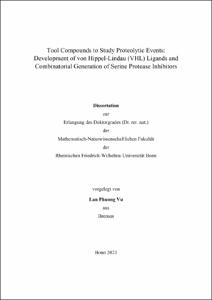Vu, Lan Phuong: Tool Compounds to Study Proteolytic Events: Development of von Hippel-Lindau (VHL) Ligands and Combinatorial Generation of Serine Protease Inhibitors. - Bonn, 2023. - Dissertation, Rheinische Friedrich-Wilhelms-Universität Bonn.
Online-Ausgabe in bonndoc: https://nbn-resolving.org/urn:nbn:de:hbz:5-72637
Online-Ausgabe in bonndoc: https://nbn-resolving.org/urn:nbn:de:hbz:5-72637
@phdthesis{handle:20.500.11811/11084,
urn: https://nbn-resolving.org/urn:nbn:de:hbz:5-72637,
author = {{Lan Phuong Vu}},
title = {Tool Compounds to Study Proteolytic Events: Development of von Hippel-Lindau (VHL) Ligands and Combinatorial Generation of Serine Protease Inhibitors},
school = {Rheinische Friedrich-Wilhelms-Universität Bonn},
year = 2023,
month = oct,
note = {Among other principles of regulation, protein functions are controlled by the intracellular or extracellular proteolytic activity of proteases. Proteolysis is a process in which proteins are cleaved, leading to activation or degradation of targeted substrates. For protein degradation in cells, lysosomal and proteasomal degradation constitute the two major mechanisms responsible for intracellular protein homeostasis. The proteasomal pathway as executed by the ubiquitin-proteasome system (UPS) is essential for a variety of cellular events. Medicinal chemistry efforts can provide compounds to efficiently influence the UPS or support valuable insights into biological functions of target proteins. Several studies have demonstrated that E3 ligases can induce proteasomal degradation of target proteins through ubiquitination. Despite the abundance of E3 ligases, the von Hippel-Lindau (VHL) E3 ligase has been shown to exhibit particular potential for the development of proteolysis-targeting chimeras (PROTACs). In recent years, the use of PROTACs for targeted protein degradation has gained significant interest. A large number of successful PROTACs contain a VHL ligand, connected via a linker to a moiety for interaction with the target protein. Thus, this thesis is focussed on (i) an alternative and optimized synthetic route to functional VHL ligands to address the limitations of current literature, whereby providing a more accessible strategy for the development of new PROTACs, (ii) exploring the largely unexplored structure-activity relationship (SAR) of the phenylene core of VHL ligands and improving its binding affinity, (iii) generation of aptamer-based PROTACs that combine the features of aptamers and PROTACs, which involved the incorporation of a green fluorescent protein (GFP)-type dye that becomes fluorescent upon binding to an RNA aptamer, and lastly, (iv) a combinatorial approach to identify substrate-analogue inhibitors for therapeutically relevant serine proteases, such as thrombin, factor Xa, matriptase, elastase, and cathepsin G. This approach involves generating diketomorpholines as key intermediates using solid-phase synthesis. Overall, this work provides profound insights into the development of new VHL E3 ligase ligands, which can be utilized in the PROTAC technology, and the establishment of an innovative approach for accessing inhibitors for therapeutically relevant serine proteases.},
url = {https://hdl.handle.net/20.500.11811/11084}
}
urn: https://nbn-resolving.org/urn:nbn:de:hbz:5-72637,
author = {{Lan Phuong Vu}},
title = {Tool Compounds to Study Proteolytic Events: Development of von Hippel-Lindau (VHL) Ligands and Combinatorial Generation of Serine Protease Inhibitors},
school = {Rheinische Friedrich-Wilhelms-Universität Bonn},
year = 2023,
month = oct,
note = {Among other principles of regulation, protein functions are controlled by the intracellular or extracellular proteolytic activity of proteases. Proteolysis is a process in which proteins are cleaved, leading to activation or degradation of targeted substrates. For protein degradation in cells, lysosomal and proteasomal degradation constitute the two major mechanisms responsible for intracellular protein homeostasis. The proteasomal pathway as executed by the ubiquitin-proteasome system (UPS) is essential for a variety of cellular events. Medicinal chemistry efforts can provide compounds to efficiently influence the UPS or support valuable insights into biological functions of target proteins. Several studies have demonstrated that E3 ligases can induce proteasomal degradation of target proteins through ubiquitination. Despite the abundance of E3 ligases, the von Hippel-Lindau (VHL) E3 ligase has been shown to exhibit particular potential for the development of proteolysis-targeting chimeras (PROTACs). In recent years, the use of PROTACs for targeted protein degradation has gained significant interest. A large number of successful PROTACs contain a VHL ligand, connected via a linker to a moiety for interaction with the target protein. Thus, this thesis is focussed on (i) an alternative and optimized synthetic route to functional VHL ligands to address the limitations of current literature, whereby providing a more accessible strategy for the development of new PROTACs, (ii) exploring the largely unexplored structure-activity relationship (SAR) of the phenylene core of VHL ligands and improving its binding affinity, (iii) generation of aptamer-based PROTACs that combine the features of aptamers and PROTACs, which involved the incorporation of a green fluorescent protein (GFP)-type dye that becomes fluorescent upon binding to an RNA aptamer, and lastly, (iv) a combinatorial approach to identify substrate-analogue inhibitors for therapeutically relevant serine proteases, such as thrombin, factor Xa, matriptase, elastase, and cathepsin G. This approach involves generating diketomorpholines as key intermediates using solid-phase synthesis. Overall, this work provides profound insights into the development of new VHL E3 ligase ligands, which can be utilized in the PROTAC technology, and the establishment of an innovative approach for accessing inhibitors for therapeutically relevant serine proteases.},
url = {https://hdl.handle.net/20.500.11811/11084}
}






